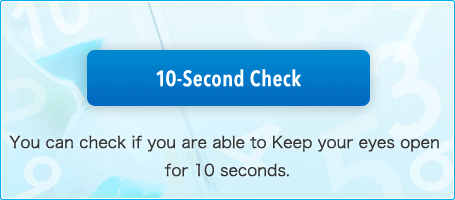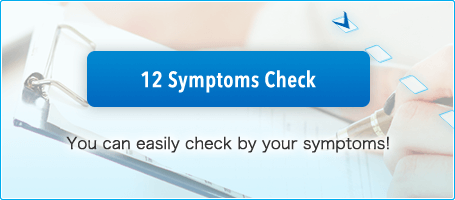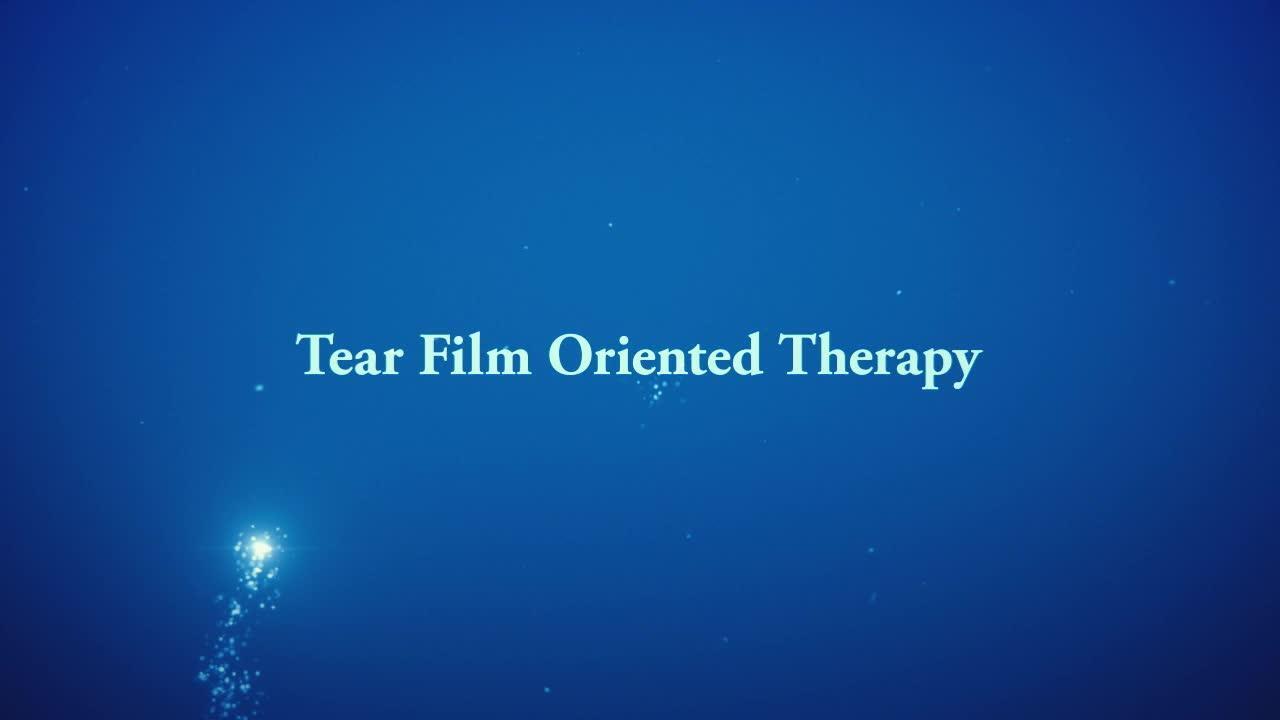Even if a high volume of tears are secreted, the eye surface can soon become dry because of the poor quality of tears. To determine the quality of tears, break up time (BUT), the duration from eye opening to breakage of the tear film on the eye surface, is measured. If the BUT is short, dry eye is suspected.
Dry Eye
Check Dry Eye
You can check yourself for the likelihood of having dry eye on this page.
If you experience any symptoms for suspected dry eye, see an ophthalmologist at a nearby clinic.
You can check if you are able to Keep your eyes open for 10 seconds.
Santen Products
Dry Eye Causes of
Dry Eye Treatment of
Dry Eye Prevention of
Dry Eye Dry Eye Q&A Issue Focus:
VDT Syndrome
What is Dry Eye
What Type of Disease is Dry Eye?
The disease of dry eye is characterized by injuries to the eye surface associated with an uneven supply of tears, which protect the eye, a lack of volume of tears, or a collapse of the qualitative balance of tears. Hence, dry eye may be viewed as a disease of tears. With the recent trends toward an aging general population and an increased use of air conditioners, computers, and smart phones, as well as an increase in the number of contact lens wearers, the number of dry eye patients has steadily increased.
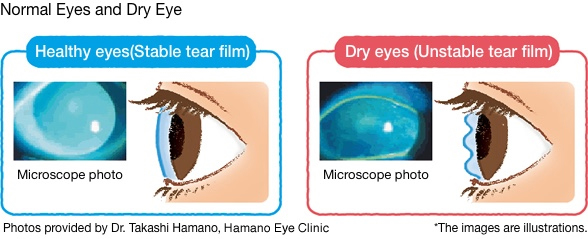
Tears-The Key to the Protection of Our Eyes
By covering the eye surface, tears serve as a barrier which protects the eye.
While a wide variety of factors can cause dry eye, the use of computers, contact lenses, air conditioners, etc., in particular, is likely to increase tear evaporation and make tears unstable, which in turn can injure the cells on the eye surface.
In addition, blinking serves as a stimulant for promoting tear secretion to shed tears, and ensure an even distribution of tears over the eye surface.
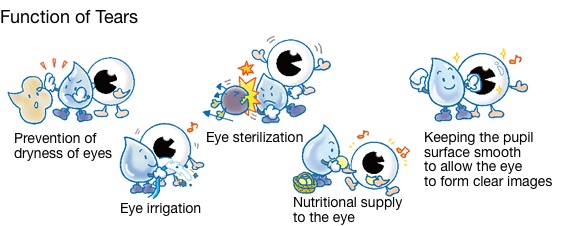
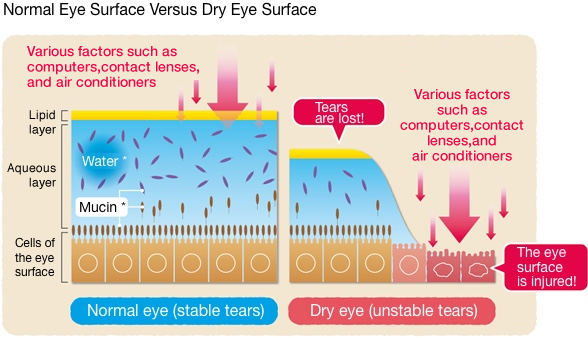
What Ocular Symptoms are Associated with Dry Eye?
Dry eye patients suffer from not only typical dry eye symptoms, such as dryness of eyes, but also many other symptoms.
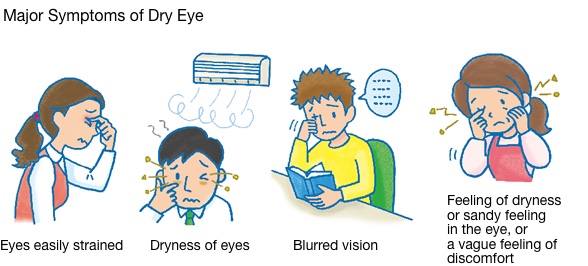
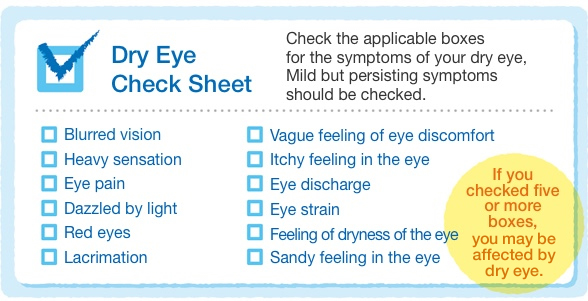
Feeling of Dryness of the Eyes
If you feel your eyes are dry while using a computer, playing a TV game, or doing detailed work, you may have a decreased frequency of blinking and a reduced volume of tears.
Eyes in such a dry state are likely to be damaged (injured) on the surface. If this state is left untreated, not only the eye surface, but also the cornea and conjunctiva may be adversely affected.
Severe dry eye is sometimes associated with Sjogren's syndrome, a disease relatively common among middle-aged women. Don't ignore the symptoms if you have any and consult an ophthalmologist.
Blurred Vision
Among dry eye patients, how objects are seen is sometimes affected in some forms such as blurred vision even with good visual acuity. This is because tears become unstable in the presence of a wide variety of factors; for example, the ‘ ’ marking on the eye chart is perceived as being blurred as illustrated below.
’ marking on the eye chart is perceived as being blurred as illustrated below.
Dry eye not only causes dryness of the eye and eye strain, but also affects how objects are seen.
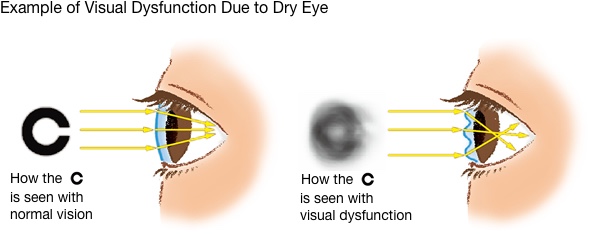
Sandy Feeling in the Eye
In the case of dry eye, the volume of tears, which protect the eye, decreases, and the cornea and conjunctiva may be injured. This in turn can cause a sandy feeling in the eye and a sensation of having something in the eye. The likelihood of conjunctivitis and keratitis also increases.
Eye Strain

Do you ever feel eye strain? This symptom may be a sign of dry eye.
The condition of dry eye is an ocular disease characterized by damage (injuries) to the eye surface due to a lack of tear volume, which protects the eye, or a collapse of the qualitative balance of tears. Don't immediately conclude that ‘My symptoms are not of concern because it is nothing more than eye strain that is not so severe.’ See an ophthalmologist if you often feel eye strain.
Causes of Dry Eye
‘I recently often experience eye strain.’This is a possible sign of dry eye when looking at the screens of personal computers, televisions, or mobile phones.
An increasing number of individuals now feel that they are likely to experience eye strain, or a vague feeling of discomfort in their eyes.
The feeling of dryness of the eye, or dry eye, has recently been attracting attention as a cause of such symptoms, including eye strain.
The condition of dry eye is an ocular disease characterized by damage (injuries) to the eye surface due to a lack of volume of tears or a compositional change in tears.
The progression of dry eye may lead to reduced visual acuity, eye pain, and corneal epithelial detachment (a disease characterized by corneal drying and detachment).
Individuals with the Following Lifestyles are Likely to Experience Dry Eye!
Despite the fact that the condition of dry eye is experienced by a large number of people, it is not commonly recognized as a disease. If you meet the following criteria, you need to pay special attention to your eyes!
If you feel something unusual in your eyes, don't hesitate to see an ophthalmologist.
If you follow your doctor's instructions with regard to daily activity, you may be able to relieve your symptoms, and become more comfortable during the day.
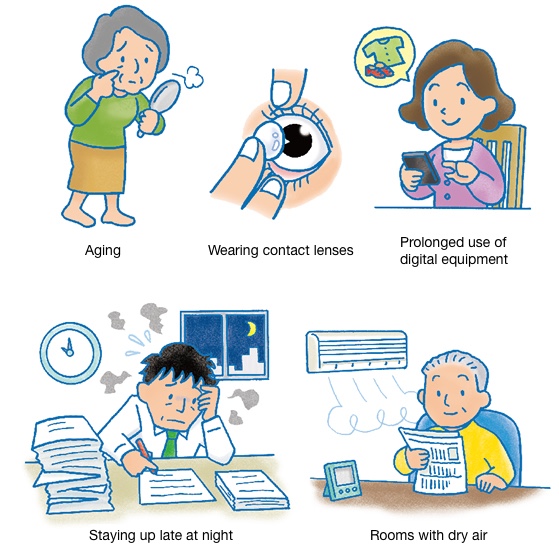
Contact Lens Wearers
Contact lens wearers are more likely to have dryness of the eyes than those who do not wear contact lenses.
Individuals who experience symptoms, such as a sandy feeling in their eyes or hyperemia, likely have dry eye.
Individuals Who Use Personal Computers for Long Periods of Time
Individuals who use personal computers for business purposes for long periods of time every day and, in particular, those who perform tasks requiring visual concentration, such as handling detailed numbers and characters, need to pay special attention to their eyes! Individuals who look at a display with a fixed gaze while playing an Internet game also need to be vigilant.
Individuals Who Stay in Air Conditioned Rooms for Long Periods of Time
Individuals who work in air conditioned offices throughout the day and those who have their face defenselessly exposed to the flow of air from air conditioners at home need to pay special attention to their eyes. Their eyes will soon become dry.
Individuals Who Underwent Refractive Surgery Within the Past Six Months
Refractive surgery is a surgical operation intended to improve visual acuity by trimming the cornea using a laser. In most cases, transient hypoesthesia is observed and causes dry eye as a surgical complication about 3 to 6 months after surgery. Symptoms, for the most part, resolve after a given period of time; however, dry eye sometimes remains unresolved for a long period of time.
Individuals Who Stay up Late at Night
Do you lack sleep due to overtime work, late night drinking, or midnight web surfing or telephone calls? Individuals who experience eye problems in the afternoon or at night likely have dry eye
Individuals Who Often Travel or Go on Business Trips
Individuals who often travel long distances on airplanes for business purposes and individuals who frequently stay at hotels need to be vigilant with their eyes.
Patients with Pollinosis
Pollinosis, a spring annoyance, is an allergic condition of the eye and nose caused by pollen from the Japanese cedar trees and other plants.
Pollinosis is characterized by symptoms, such as eye itching, hyperemia, and excess lacrimation, and these symptoms also develop in dry eye. Dry eye and pollinosis have similar ocular symptoms, and both diseases may occur concurrently.
Frequent Drivers
Individuals who drive for many hours, such as taxi, bus, and truck drivers, sales persons who often use cars for business and those who enjoy driving as a hobby may have dry eye if they feel discomfort during driving.
Elderly Persons
Changes occur in our body as we age, and this is also true for our eyes.
The secretory function of the lacrimal gland, an organ that produces tears, is known to decrease with aging, resulting in a decrease in the volume of tears secreted.
Treatment of Dry Eye
Dry Eye is a Disease That Requires Proper Diagnosis and Treatment by an Ophthalmologist.
The term dry eye generically refers to chronic diseases of tears and eye surfaces due to a variety of factors associated with eye discomfort and visual functional abnormalities.
Dry eye is sometimes undistinguishable from transient discomfort and illnesses because its associated symptoms and causes are diverse. Therefore, the right diagnosis and treatment cannot be made without an ophthalmologist.
Leaving Symptoms Untreated May Lead to Unfavorable Outcomes
The symptoms of dry eye are diverse, ranging from dryness of the eye to eye strain and pain.
Whether such symptoms are attributed to transient illnesses or eye surface disorders cannot be determined without due examinations at an eye clinic.
Leaving these symptoms untreated may unconsciously aggravate the symptoms, which in turn can cause complications of other eye diseases.
Early Treatment and Periodic Clinical Visits is the Key to the Cure
Dry eye is a disease caused by a quantitative or qualitative change in tears due to lifestyle-related factors or other diseases. Therefore, the simple replenishment of water with commercially available eye drops may sometimes be insufficient to prevent this disease. In addition, eye irrigation with tap water or commercially available eye drops may even worsen the symptoms.
If you have any concerns, do not hesitate to visit and consult with an ophthalmologist.
Flow of Consultation and Treatment at an Eye Clinic
What exams and treatments are performed at an eye clinic? Here is a flow from the consultation to the periodic visit.
What You are Asked During the Consultation
In the consultation, you will be asked about your ocular symptoms, life environment, lifestyle, and other aspects to help determine the causes of your dry eye.
If you have any other concerns, please feel free to consult your doctor.
- Symptoms
What symptoms, how long your symptoms have persisted, etc.
- Life environment and lifestyle
Lack of sleep, stress, use of air conditioners, use of contact lenses, physical fatigue, eye irrigation habits, etc.
- Behaviors causing reduced blinking frequency
Use of computers, television games, driving vehicles, reading, etc.
- Influence of other diseases and medications
Diseases such as Sjogren's syndrome, Stevens-Johnson syndrome, collagen disease, and rheumatism, some hypotensives and tranquilizers, etc.
Examination for Dry Eye
The following tests are performed to diagnose dry eye:
- Visual test for ocular diseases
This is always performed as the first examination at an eye clinic. The visual aquity data from this test may help find dry eye and other kinds of eye diseases.
- Microscopic examination for the presence/absence and severity of eye injuries
This is an examination intended to examine injuries on the eye surface. When instilling fluorescein, a yellow to orange reagent, to the eye, any injuries in the cornea (pupil) are stained. Stained portions are examined for the presence/absence and severity of injuries using a slit lamp microscope.
- BUT test to evaluate the quality of tears
- Schirmer's test to determine the volume of tears
This is a test to determine the volume of tears using a dedicated graduated test paper inserted into the end of the lower eyelid for 5 minutes. The volume of tears is measured as the length of the portion of the test paper moistened by tears. If the volume of tears is low, dry eye are suspected. To avoid the influence of tears secreted upon the stimulation of inserting the test paper, a modified Schirmer's test may be performed with the use of a topical anesthetic.
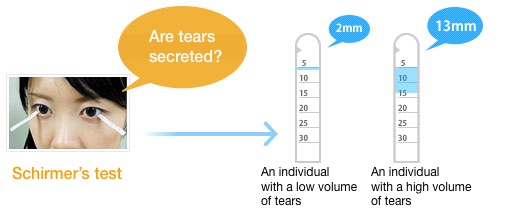
Prescriptions and Medications
Specialized treatments are effective for dry eye. There are two major types: treatments with ophthalmic solutions/suspensions and treatment with lacrimal punctum closure.
- Treatments with ophthalmic solutions/suspensions
Ophthalmic solutions/suspensions are most commonly used for treating dry eye. They include artificial tears with a composition similar to that of natural tears, and therapeutics containing sodium hyaluronate for keratoconjunctival epithelial disorders. An eye drop which secretes the components of tears has also been available in some countries in Asia. This has recently been marketed, and is used to treat dry eye. Ophthalmic solutions/suspensions should be used as directed by a physician or pharmacist.
- Treatment with punctal plugs if the ophthalmic solutions/suspen
If the ophthalmic solutions/suspenIf the ophthalmic solutions/suspensions are ineffective, treatment via lacrimal punctum closure may be performed, in which the lacrimal punctum, the exit path for tears, is artificially closed to suppress tear outflow and allow a sufficient volume of tears to accumulate on the eye surface. A plug made of silicone or synthetic resin is inserted into the lacrimal punctum. Alternatively, the lacrimal punctum may be surgically closed with a suture.

Clinic Visits and Periodic Check-ups
Even if your symptoms resolve with eye drops and other medications prescribed at the eye clinic, never consider that your dry eye has been completely cured; however, you should still follow your ophthalmologist's instructions and visit the clinic as directed to maintain the good condition of your eyes.
Prevention of Dry Eye
What You Should Pay Attention to
Some environmental conditions can increase the evaporation of tears and make your eyes more likely to become dry. In particular, improving the status of your use of personal computers, air conditioners, and contact lenses is effective in mitigating the symptoms of your dry eye.
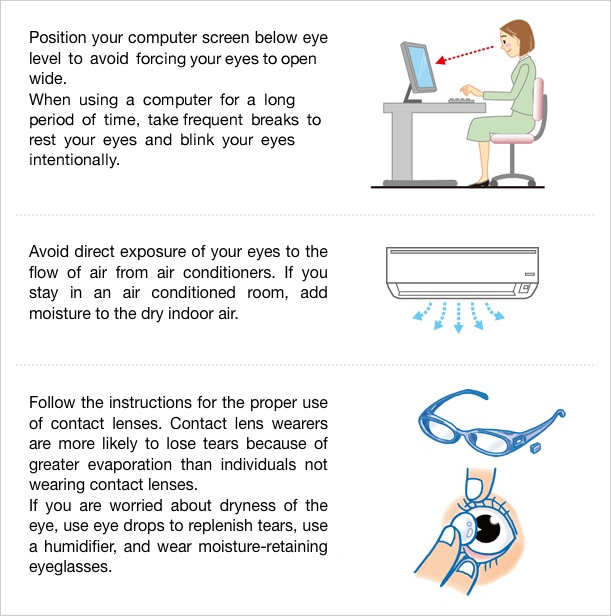
Dry Eye Q&A
Frequently Asked Questions
A wide variety of dry eye treatments are available depending on the patient's symptoms and condition.
In general, mild cases of dry eye are treated using eye drops that help retain moisture, eye drops containing moisturizing ingredients, and other formulations to replenish tears that have decreased. It is very important to improve the quality an quantity of tears in the treatment, and eye drops can often help. However, if dry eye cannot be managed with eye drops, treatments may be given to suppress the outflow of tears by artificially closing the lacrimal punctum, the outlet of tears.
If you are worried about your symptoms, it is important that you see an ophthalmologist so that the severity of your dry eye and the best treatment for your dry eye can be determined.
Related link Treatment of Dry Eye
This treatment is known as punctal plugging, in which the outflow of tears is suppressed by closing the lacrimal punctum, the outlet of tears, causing tears to accumulate on the eye surface.
This treatment can be performed via two methods, by inserting a tiny silicone plug to the upper and lower lacrimal puncta, and by suturing each lacrimal punctum (known as punctal closure surgery).
This treatment is generally used to treat relatively severe cases of dry eye, and is not applicable to all patients. Atelocollagen plugs that can be used for relatively mild dry eye have recently been developed.
Related link Treatment of Dry Eye
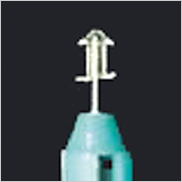
The following measures are available:
Preventive measures you can implement while using a computers include:
- Blinking your eyes intentionally
- Using a humidifier to add moisture to dry indoor air
- Positioning your computer screen below eye level
- Sitting in a position where the flow of air from air conditioners do not blow directly into your eyes
- Taking adequate eye breaks
If we continue to look at a television or computer screen (gazing), our blinking frequency decreases to nearly 1/3 to 1/4 of the normal level, or about 20 to 30 blinks per minute, which in turn can dry and injure the pupil surface (cornea). The number of people with this type of dry eye has recently increased. If you have severe symptoms, such as eye strain and a sandy feeling in the eye, or if you do not feel relief from your symptoms even after a sufficient eye break, it is a red signal for dry eye. You are encouraged to consult an ophthalmologist who can check your eyes for injuries.
Consult an ophthalmologist and choose the type that fits you.
Dry eye in wearers of contact lenses may be caused by a wide variety of factors, including the material, size, and fitting of the contact lens. Among the many types of contact lenses there are soft contact lenses that are made using a polymeric substance that has high moisture retention, which is expected to lessen the sensation of dryness. Schedule a check-up with an ophthalmologist and have suitable contact lenses prescribed for your condition.
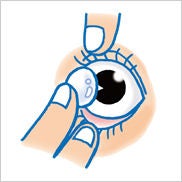
The use of contact lenses is considered to be closely associated with dry eye.
About 80% of soft contact lens wearers and about 70% of hard contact lens wearers complain of dryness of the eyes. Tears serve as a lubricant between the contact lens and the pupil (cornea) to protect your eyes. In a state where there is a decrease in tears, the cornea and conjunctiva are likely to be injured, which in turn can reduce their resistance to bacteria and cause severe corneal infections. In addition to the proper maintenance of your contact lenses, be sure to undergo periodical check-ups with an ophthalmologist.
At present, no treatments are available to eliminate all causes of dry eye.
Mild and severe symptoms are treated in considerably different ways because dry eye is caused by a wide variety of factors.
You are encouraged to consult an ophthalmologist who can help you decide the proper treatment for your symptoms.
Related link Treatment of Dry Eye
Subjective symptoms, such as dryness or a sandy feeling in the eye, as well as eye surface disorders (injuries) may worsen.
In addition, bacteria may enter the eye via the injuries and cause severe corneal infections. If people with these conditions wear contact lenses, their symptoms may worsen.
If you experience these conditions, don't leave the symptoms untreated and consult an ophthalmologist.
Related link Treatment of Dry Eye
The volume of tears secreted decreases with age because the secretory function of the lacrimal gland, which produces tears, decreases.
Decreased tear secretion is considered to be one of the causes of dry eye.
On the other hand, the function of tear drainage (lacrimal drainage) may sometimes decrease, resulting in a decreased volume of tears flowing out. This means that dry eye do not always occur with aging.
If the eye drop formulation you bought at the pharmacy does not relieve your symptoms, consult an ophthalmologist.
While tears play a role in delivering oxygen and nutrients to the pupil (cornea) and in killing bacteria that have entered the eye, too frequent instillation of eye drops may cause valuable tears to be washed away.
In addition, patients with dry eye may have their eyes injured by the influence of ingredients in their eye drops because the ingredients are not diluted by their tears. If you do not experience relief from your symptoms, consult an ophthalmologist.
Yes, it is ‘likely that you have dry eye.’
Even if your rating on the ‘Check Dry Eye!’ scale applies to some symptoms, it does not mean more than you ‘likely have dry eye.’ In addition, you may have a disease other than dry eye. If you experience several problematic subjective symptoms, don't leave these symptoms untreated and see an ophthalmologist to undergo an expert examination.
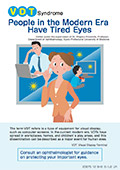
VDT Syndrome
People in the Modern Era Have Tired Eyes
